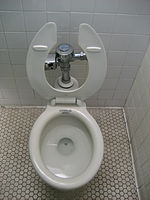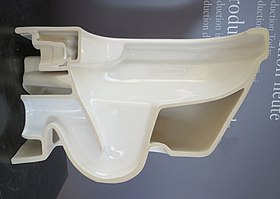Toilet
![]()
Latrine is a redirect to this article. For other meanings, see Toilet (disambiguation) and Latrine (disambiguation).
![]()
Örtchen is a redirect to this article. For another meaning, see Oertchen.
![]()
This article or section needs revision. More details should be given on the discussion page. Please help improve it, and then remove this tag.
The toilet [to̯aˈlɛtə] (from French toile 'cloth'), also Klosett (from English closet, also just short Klo), zero-zero (from '00') or the abbreviation WC (from English water closet 'water closet') refers to a sanitary device for the reception of bodily excretions (especially feces and urine) since about the 19th century. In addition, the terms also refer to the place or room in which the device is located. A toilet serves a more comprehensive purpose than a urinal, which is only used for the removal of urine.
In 2001, the World Toilet Organization was founded, which aims to improve hygienic conditions and access to toilet facilities and proclaimed World Toilet Day. About 6 in 10 people worldwide did not have access to hygienic sanitation in 2019, for a total of about 2.5 billion people.
,_StVO_2013.svg.png)
Traffic sign on federal motorways in Germany

Logo of the World Toilet Organization

Historical toilet signpost
Term
The term toilette is derived from the French language, where "toilette" meant the process of make-up, hairdressing and dressing the ladies of the court - originally, dressing and washing tables were called "toilettes". Since the women at court had special dressing rooms for their toilettes and also performed their emergency urination there on their bodily chairs, this term became established, at first only outside France, for the lavatory itself, in German in the 19th century and in American English from the end of the 19th century. The equivalent French toilettes (in the plural) has only been lexicographically recorded since 1964.
Other - often joking and/or obsolete - terms for this (small) room are the locus (from Latin locus 'place' or locus necessitatis 'place of need'), the latrine (from Latin lavare 'to bathe/wash'), the privé (French privé 'confidential, private'), the retirade (Latin- Italian-French 'place of retreat'), the privy (a variant of 'stepping out'), the privy or even the quiet lavatory.Italian-French 'place of retreat'), the privy (a variant of 'to exit'), the privy or even the quiet lavatory. Vulgar terms are shithouse (Middle High German schîzhûs, originally not offensive), Schlotte - actually a cavity in water-soluble rock - or, especially in military jargon, Donnerbalken. Dialectal terms are in Austria and Bavaria also Häusl, in Switzerland Hüüsli, widespread in the southwest of the German language area then AB (veiling for privy or privy). In former times usual veiling terms were furthermore Heimlichkeit or heimliches Gemach as well as Dansker.
All these terms show the high sense of shame towards one of the most intimate human subjects as well as the desire to be alone while using a toilet and are thus euphemisms derived from things surrounding the toilet; none means in its origin the bowl itself.
Signs on toilets often bear the inscription 00 or 0. This arose because in hotels in the 19th century the toilet rooms were usually located near the elevator or the staircase. Since the numbering of the rooms usually began there, the toilet rooms bore the room number 0 or also two-digit 00.
The toilets are usually equipped with a toilet seat and provided utensils such as a waste bin, toilet brush and toilet paper.

"Thunderbolts" with soldiers of the First World War.
Types
Porcelain Standard Basin
The most widespread are porcelain WCs with flush toilets and sewers. There are three main types of construction:
Low-flush
Seat toilet where the excrements fall into the water of a siphon located under the user's buttocks. As a result, the development of odors is low, because the water prevents contact of the excrement with the air in the room. However, one disadvantage compared to the flat flush is that the water often splashes up against the buttocks. This form is common in North America, France and England, for example, and increasingly in Germany and Austria.
A variation of this flush system is the cascade toilet (also called Cascade flush): The drain to the siphon is at the very back (on the wall side), and the water is prevented from splashing up by a ceramic tongue.
The flushing process differs between European and North American toilets: While in Europe the water running in during flushing transports the excrement away, in North America part of the flushing water is introduced as a water jet into the siphon, which often meanders several times. The function is that of a jet pump, the water serves as a propelling medium, to the flushing end that of a siphon. The contents of the bowl are thus emptied by suction and then refilled. The water level in American deep dishwashers is also significantly higher than in European ones.
One problem with washdown toilets is that the drain pipes are narrowed by deposits. The result is that the WC bowl is filled by the flushing water faster than it empties through the drain. The excrement floats to the top and only the water from the lower part of the siphon drains slowly.
Flat flush
Sitting toilet with a kind of step under the user's buttocks onto which the excreta fall. The drain to the siphon is at the front (towards the centre of the room) in the case of the flat flush valve. The excreta only disappear into the sewage system when flushing via the siphon. This makes it possible to take a stool sample, as is useful in hospitals and for doctors. The biggest disadvantage of this type of construction is the strong odour development, which is why public and private toilets have been and are being converted to low-flush toilets since the 1990s.
Children's toilet
In some facilities for smaller children, such as kindergartens, there are children's toilets.
To get a child used to using a potty, there are toilet seats with a smaller opening so that the child cannot fall into the toilet. For the use of both, children up to kindergarten age always need the assistance of a caregiver.
Squat toilet
In a squat toilet (sometimes called a standing toilet), the user does not sit on a bowl, but is in a squatting position. The toilet can be a simple hole or a channel in the floor. Meanwhile, there are larger, basin-like constructions. Squat toilets are common in Asia, Southern Europe and Islamic countries. Because there is no direct contact between the body and the toilet, they are often considered particularly hygienic. For the inexperienced, the use is quite difficult. Conversely, the use of a squat toilet can also be a problem for people who are not used to it and find the contact between the buttocks and the toilet seat unhygienic. A remarkable feature of the squat position is that the rectum is not bent, unlike with sit-down toilets.
Standing or hanging toilet bowls
In the past, it was common to place toilet bowls freely in the room. The voluminous drain pipe ran through the ceiling and then either freely in front of the wall or in a brick wall niche under the plaster.
The pipes are usually invisible behind a drywall construction. As a simple solution to completely conceal the drain pipe and at the same time facilitate cleaning of the floor, it was a good idea to suspend the toilet bowl from the construction in a wall-hung position. Suspended toilets have the widest distribution. Their connection dimensions are determined according to DIN EN 33:2011-11.
Shower toilets
Modern toilets are found in the form of shower toilets, which are installed in homes with a share of 10 percent in Switzerland and 1 percent in Germany.
In means of transport
Unisex toilets are generally common on railways. Attempts to establish gender-segregated toilets have not been successful.
Open design
The "open design" is also referred to as a downpipe toilet, where emptying takes place directly to the outside. This used to be the most widespread system on the railways, which is why it was forbidden to use the toilet in railway stations. The advantages of simple construction, constant availability and the fact that emptying is not necessary are offset by pollution and environmental problems.
Closed design
Toilets with a closed design have a waste water tank that is normally emptied into the waste water every one to two days. The closed types (with or without treatment of the waste water) are emptied mainly by negative pressure; this makes it possible to save water when flushing.
- Vacuum toilets: Vacuum toilets are used in aircraft, on ships, modern trains and in manned space flight. Toilets in space are designed on a vacuum cleaner-like principle because of the lack of gravity. The opening is only about the size of a hand and the use must be trained.
- The advantage of chemical toilets is that the waste water has to be disposed of less often, the disadvantage is the environmentally harmful chemicals.
- During the biological treatment of wastewater, microorganisms convert the faeces in such a way that the water portion can be reused as service water. Biological toilets allow long emptying cycles. The disadvantage is that the system can "tip" if, for example, the toilet bowl is cleaned with the wrong chemicals.
Other types
- Thunderbolts ("outhouse", "terraced lavatory")
- Toilet with septic tank
- Toilet with antiseptic tank, about the size of a canister for the motor home or as a craneable plastic toilet cell for construction sites and events.
- Toilet with septic tank and clarification bed (constructed wetland) for liquid faeces
- Composting toilet or dry separation toilet (TTC): Toilet with solid composting and urine separation.
- Compost toilet without urine separation
- Abortkübel - miner's toilet for the miners underground, as well as for the municipal waste disposal ("Fasslwirtschaft", Graz: 1872, soap factory)
- Public toilet - larger public toilet facility
- On-board toilet on ships, in airplanes, trains or coaches
- Fire closet - a type of sanitary facility with integrated excrement incineration that was being developed around 1900.
- Bedpan, urine bottle, chamber pot - Container for bowel and bladder emptying
- Mo San for slums
Alternatively, vacuum toilets are increasingly being installed where material flow separation is necessary (such as in the radiology department of hospitals) or where ecological wastewater treatment with anaerobic processes is planned. In some cases, other toilets with the possibility of urine separation are also being tested.
· 
Toilet house in Berlin, colloquially known as Café Achteck (octagon)
· 
Freestanding latrine, El Salvador
·
In oriental countries you can often find a water hose (left)
·
Wooden toilet house at a pond in Brandenburg near the border to Poland
· _WLA_WC_3_from_Lower_Austria_fire_fighting_and_civil_protection_at_47._Landestreffen_der_NÖ_Feuerwehrjugend_2019_in_Mank,_Austria.jpg)
WC container from the Lower Austrian Fire Brigade and Disaster Management at the 47th Lower Austrian Fire Brigade Youth Meeting 2019 in Mank, Austria.
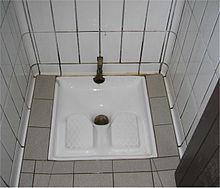
Squat toilet at a French motorway petrol station
.jpg)
Train toilet used by Josef Stalin on his journey to the Potsdam Conference in 1945, Josef Stalin Museum in Gori
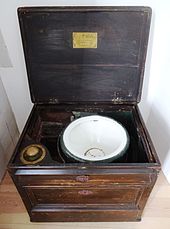
Travelling toilet, around 1850 (Eutin Castle)
| Typical deep flush toilet of American design with pressure flush. In the sump the water jet opening into the siphon | Section through a low flush WC with open flush rim (rimless WC) in the Mettlach Ceramics Museum |
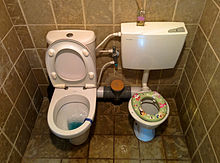
On the right a children's toilet
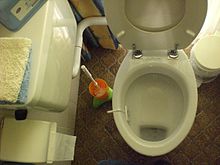
Flat toilet bowl with a non-water-saving flushing system
.jpg)
Children's toilet seat
Questions and Answers
Q: What is a toilet?
A: A toilet is a place where humans get rid of waste that comes from their bodies (urine and feces).
Q: How do most toilets work?
A: Most toilets use water to flush the waste through plumbing into a sewage system.
Q: Are there any types of toilets that do not use water?
A: Yes, some modern toilets do not use water and are called dry toilets.
Q: What other names can a room with a toilet be called in the United States?
A: A room with a toilet can be called a "restroom" or "bathroom" in the United States.
Q: What is a toilet called in other places?
A: In other places, a toilet can be called the toilet or the water closet (WC).
Q: What type of waste do humans get rid of in a toilet?
A: Humans get rid of waste that comes from their bodies (urine and feces) in a toilet.
Q: Where does the waste go after it is flushed down the toilet?
A: The waste is flushed through plumbing into a sewage system.
Search within the encyclopedia


